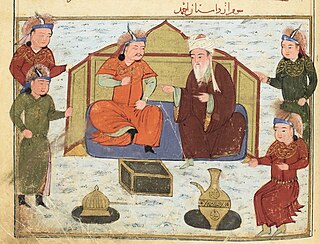Related Research Articles
Nasir al-Din, was originally a honorific title and is an Arabic masculine given name. There are many variant spellings in English.

The Kart dynasty, also known as the Kartids, was a Sunni Muslim dynasty of Tajik origin closely related to the Ghurids, that ruled over a large part of Khorasan during the 13th and 14th centuries. Ruling from their capital at Herat and central Khorasan in the Bamyan, they were at first subordinates of Sultan Abul-Fateh Ghiyāṣ-ud-din Muhammad bin Sām, Sultan of the Ghurid Empire, of whom they were related, and then as vassal princes within the Mongol Empire. Upon the fragmentation of the Ilkhanate in 1335, Mu'izz-uddin Husayn ibn Ghiyath-uddin worked to expand his principality. The death of Husayn b. Ghiyath-uddin in 1370 and the invasion of Timur in 1381, ended the Kart dynasty's ambitions.

The Sarbadars were a mixture of religious dervishes and secular rulers that came to rule over part of western Khurasan in the midst of the disintegration of the Mongol Ilkhanate in the mid-14th century. Centered in their capital of Sabzavar, they continued their reign until Khwaja 'Ali-yi Mu'ayyad submitted to Timur in 1381, and were one of the few groups that managed to mostly avoid Timur's famous brutality.
Shams al-Din 'Ali ibn Mas'ud ibn Khalaf ibn Mihraban was the first Mihrabanid malik of Sistan. He ruled from 1236 until his death.
Qutb al-Din Muhammad was the Mihrabanid malik of Sistan from 1330 until his death. He was the son of Rukn al-Din Mahmud.
Taj al-Din was the Mihrabanid malik of Sistan from 1346 until 1350. He was the son of Qutb al-Din Muhammad.
Izz al-Din was the Mihrabanid malik of Sistan from 1352 until 1380. He was the son of Rukn al-Din Mahmud.
Qutb al-Din was the Mihrabanid malik of Sistan from 1380 until 1383. He was the son of Izz al-Din ibn Rukn al-Din Mahmud.
Nusrat al-Din Muhammad was the Mihrabanid malik of Sistan from 1318 until his death. He was the son of Nasir al-Din Muhammad.

The Mihrabanid dynasty was a Muslim dynasty that ruled Sistan from 1236 until the mid-16th century. It was the third indigenous Muslim dynasty of Sistan, having been preceded by the Saffarid and Nasrid dynasties.
Taj al-Din Shah-i Shahan Abu'l Fath or Shah-i-Shahan of Sistan was the Mihrabanid malik of Sistan from 1383 until his death. He was the son of Mas'ud Shihna.
Qutb al-Din Muhammad was the Mihrabanid malik of Sistan from 1403 until his death. He was the son of Shams al-Din Shah 'Ali.
Shams al-Din 'Ali was the Mihrabanid malik of Sistan from 1419 until his death. He was the son of Qutb al-Din Muhammad.
Nizam al-Din Yahya was the Mihrabanid malik of Sistan from 1438/1439 until his death. He was the son of Shams al-Din 'Ali.
Shams al-Din Muhammad was the Mihrabanid malik of Sistan from 1480 until around the end of the 15th century. He was the eldest son of Nizam al-Din Yahya.

Shams al-Din Juvayni was a Persian statesman and member of the Juvayni family. He was an influential figure in early Ilkhanate politics, serving as sahib-i divan under four Mongol Ilkhans−Hulagu, Abaqa, Tekuder and Arghun Khan. In 1284, Arghun accused Shams al-Din of having poisoned the Ilkhan Abaqa, who may actually have died of the effects of alcoholism; Shams al-Din was duly executed and replaced as vizier by Buqa. A skillful political and military leader, Shams al-Din is also known to have patronized the arts. The musician Safi al-Din al-Urmawi was one of those he supported.

The Hazaraspids, was a Kurdish dynasty that ruled the Zagros Mountains region of southwestern Iran, essentially in Lorestan and which flourished in the later Saljuq, Ilkhanid, Muzaffarid, and Timurid periods.
Sultan Mahmud was the last Mihrabanid malik of Sistan, from c. 1495 until c. 1537.
Shams-uddin Muhammad was the second malik of the Kurt dynasty. He ruled from 1245 until his death 1278.
References
- Bosworth, C.E. The History of the Saffarids of Sistan and the Maliks of Nimruz (247/861 to 949/1542-3). Costa Mesa, California: Mazda Publishers, 1994.